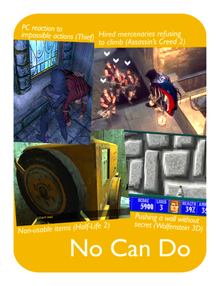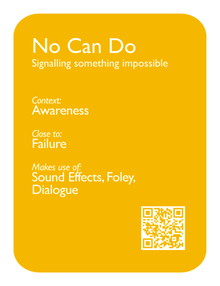Difference between revisions of "No Can Do"
ValterAlves (Talk | contribs) m |
ValterAlves (Talk | contribs) m |
||
| (10 intermediate revisions by the same user not shown) | |||
| Line 2: | Line 2: | ||
| name =No Can Do | | name =No Can Do | ||
| deckversion =1.0 | | deckversion =1.0 | ||
| − | | | + | | v10synopsis =Signalling something impossible |
| + | | v20synopsis =Signalling something impossible | ||
| patternpresentation = | | patternpresentation = | ||
| cardpresentation= | | cardpresentation= | ||
| Line 10: | Line 11: | ||
| v20backface =NoCanDo-back-v20.png | | v20backface =NoCanDo-back-v20.png | ||
| screenshots= | | screenshots= | ||
| − | | | + | | v10rel-tag1=Context:<br> |
| − | | | + | | v10rel1=[[Awareness]]<br> |
| − | | | + | | v10rel-tag2=Close to:<br> |
| − | | | + | | v10rel2=[[Failure]]<br> |
| − | | | + | | v10rel-tag3=Makes use of:<br> |
| − | | | + | | v10rel3=[[Sound Effects]], [[Foley]], [[Dialogue]]<br> |
| + | | v20rel-tag1=Context:<br> | ||
| + | | v20rel1=[[Awareness]]<br> | ||
| + | | v20rel-tag2=Close to:<br> | ||
| + | | v20rel2=[[Failure]]<br> | ||
| + | | v20rel-tag3=Makes use of:<br> | ||
| + | | v20rel3=[[Sound Effects]], [[Foley]], [[Dialogue]]<br> | ||
| revisions =Introduced in version 1.0 | | revisions =Introduced in version 1.0 | ||
| description= | | description= | ||
The interaction between the PC/player and the game world implies experimentation, at least until the rules of the game world are well understood. To signal impossible actions, designers frequently resort to sound. | The interaction between the PC/player and the game world implies experimentation, at least until the rules of the game world are well understood. To signal impossible actions, designers frequently resort to sound. | ||
| − | If we | + | If we think of a continuum between sounds of [[Achievement]] and sounds of [[Failure]], sounds of [[No Can Do]] “feel” somewhere between a neutral degree of [[Awareness]] and tending towards [[Failure]], although they don’t get close enough to the latter to the point of being similar. A [[No Can Do]] sound is mostly informative; it does not reflect a judgement on the action of the player – although it informs about something that cannot be done and, as such, that is not interesting repeating. |
Solutions for [[No Can Do]] may be diegetic or non-diegetic. In the former case, the PC usually expresses itself the impossibility through a minimal [[Dialogue]], which is sometimes accompanied by the [[Foley]] of the failing interaction. In the latter case it is common to use a [[Sound Effects|Sound Effect]] directed to the player. | Solutions for [[No Can Do]] may be diegetic or non-diegetic. In the former case, the PC usually expresses itself the impossibility through a minimal [[Dialogue]], which is sometimes accompanied by the [[Foley]] of the failing interaction. In the latter case it is common to use a [[Sound Effects|Sound Effect]] directed to the player. | ||
| − | |||
| − | |||
| − | |||
| − | |||
| examples= | | examples= | ||
| ex1=<mt p="NoCanDo" g="Assassins Creed 2" altg="Assassin's Creed 2" w="{{R16by9W}}" h="{{R16by9H}}" i=2></mt> | | ex1=<mt p="NoCanDo" g="Assassins Creed 2" altg="Assassin's Creed 2" w="{{R16by9W}}" h="{{R16by9H}}" i=2></mt> | ||
| − | | ex2=<mt p="NoCanDo" g="Thief III" altg="Thief III: Deadly Shadows" w="{{R4by3W}}" h="{{R4by3H}}"></mt> | + | | ex2=<mt p="NoCanDo" g="Thief III" altg="Thief III: Deadly Shadows" w="{{R4by3W}}" h="{{R4by3H}}">When trying to conceal a body in a place that cannot fit it, Garrett emits a “uh-uh”. No accompanying visual cue exists, in this case.</mt> |
| − | | ex3=<mt p="NoCanDo" g="Half Life 2" altg="Half-Life 2" w="{{R8by5W}}" h="{{R8by5H}}"></mt> | + | | ex3=<mt p="NoCanDo" g="Half Life 2" altg="Half-Life 2" w="{{R8by5W}}" h="{{R8by5H}}">When an item cannot be used, a [[Sound Effects|Sound Effect]] is used. Unless captions are activated this is the only cue the player receives [pending: double check this].</mt> |
| − | | ex4=<mt p="NoCanDo" g="LocoRoco | + | | ex4=<mt p="NoCanDo" g="LocoRoco" w="{{R16by9W}}" h="{{R16by9H}}"></mt> |
| ex5=<mt p="NoCanDo" g="Chime" w="{{R16by9W}}" h="{{R16by9H}}"></mt> | | ex5=<mt p="NoCanDo" g="Chime" w="{{R16by9W}}" h="{{R16by9H}}"></mt> | ||
| ex6=<mt p="NoCanDo" g="Wolfenstein" altg="Wolfenstein 3-D" w="{{R4by3W}}" h="{{R4by3H}}"></mt> | | ex6=<mt p="NoCanDo" g="Wolfenstein" altg="Wolfenstein 3-D" w="{{R4by3W}}" h="{{R4by3H}}"></mt> | ||
Latest revision as of 02:03, 21 August 2012

|

| |
| The card's front face | The card's back face |
Contents
Synopsis
| Signalling something impossible. |
Relationships
Context:
Awareness ![]() .
.
Close to:
Failure ![]() .
.
Makes use of:
Sound Effects ![]() , Foley
, Foley ![]() , Dialogue
, Dialogue ![]() .
.
Description
The interaction between the PC/player and the game world implies experimentation, at least until the rules of the game world are well understood. To signal impossible actions, designers frequently resort to sound.
If we think of a continuum between sounds of Achievement and sounds of Failure, sounds of No Can Do “feel” somewhere between a neutral degree of Awareness and tending towards Failure, although they don’t get close enough to the latter to the point of being similar. A No Can Do sound is mostly informative; it does not reflect a judgement on the action of the player – although it informs about something that cannot be done and, as such, that is not interesting repeating.
Solutions for No Can Do may be diegetic or non-diegetic. In the former case, the PC usually expresses itself the impossibility through a minimal Dialogue, which is sometimes accompanied by the Foley of the failing interaction. In the latter case it is common to use a Sound Effect directed to the player.
Examples
  Half-Life 2: When an item cannot be used, a Sound Effect is used. Unless captions are activated this is the only cue the player receives [pending: double check this].
|





